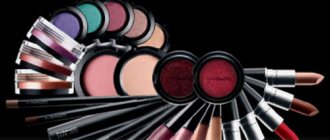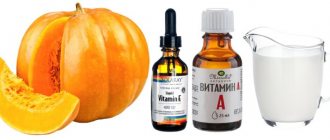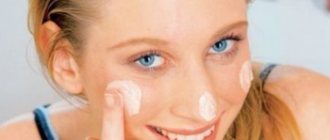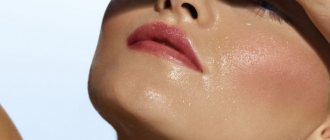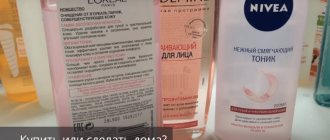Types of oily facial skin
Oily skin is called seborrhea. She is characterized by:
- enlarged noticeable pores;
- dense and pronounced relief, lack of smoothness;
- acne;
- oily shine;
- dull gray-yellow color.
With seborrhea, blush practically does not appear, because blood circulation is slowed down.
This type, depending on the composition of sebum (sebum), comes in three types:
- Liquid seborrhea. Sebum consists of unsaturated fatty acids. The face begins to shine almost immediately after washing or cleansing, due to increased sebum secretion. The pores are noticeable, but they are empty and unclogged. There are no black and white dots (comedones and milia). A comforting fact: such skin does not experience inflammation due to clogged pores.
- Thick seborrhea. Sebum consists of saturated fatty acids with particles of exfoliated epithelium. It is thick and clogs pores. Because of this, comedones, milia, and subcutaneous areas appear, often with inflammatory processes. The advantage is the absence of greasy shine.
- Mixed seborrhea. Those with this subtype are the least fortunate. Oily shine and acne are present at the same time. This type of skin requires especially careful care.
The type of seborrhea is a constant phenomenon that changes in 90-95% of cases only with age. As a rule, it is a combination type, when oily skin is present on the face in the T-zone: forehead, nose, chin.
Seborrhea has temporary problem conditions:
- Dehydration. Moisture deficiency develops with any type of seborrhea, because lard is not water. As a result, skin turgor decreases - wrinkles, sagging, and tightness appear. Oily skin needs constant hydration.
- Violation of the lipid barrier. This condition occurs in those with thick and mixed seborrhea. It manifests itself as dryness, irritation, peeling and itching. Oily skin begins to behave like dry skin, and this leads to mistakes in choosing care products by type.
ATTENTION!
Ekaterina Imshenitskaya
Unsaturated fatty acids create an epidermal barrier. Therefore, its violation does not occur with liquid seborrhea.
- Acne. This disease comes in inflammatory (acne, pimples) and non-inflammatory (comedones, milia) forms. If it is present, oily skin is called problematic.
Ekaterina Imshenitskaya
Seborrhea is not a disease. It is impossible to exchange therapy from one skin type to another. Problematic conditions need to be treated and their occurrence must be prevented.
Facial cleansing at home for oily skin
Clay based scrub
Black or brown clay is suitable for the procedure. You can take both types of clay at one time and mix them in equal proportions. Then add boiled water to the clay and stir to obtain the consistency of thick sour cream. Apply as generous a layer as possible to the face and wait until it dries, then carefully wash off the clay layer.
Sugar scrub
Pour a tablespoon of kitchen sugar into a tablespoon of cool milk. Apply to the skin, gently massage problem areas for three to four minutes, then wash.
Salt and lemon
This homemade facial cleanser for oily skin should not be used if there are inflammations or painful rashes on the face, since lemon juice is quite aggressive on them. Mix fine table salt with 1 tsp. lemon juice and scrub the most problematic areas of the face with a scrub. We wash ourselves with cool water. Facial cleansing at home for oily skin is not a problem for which you should immediately run to a professional for a solution. A little knowledge and training will help you become a personal cosmetologist and cope perfectly with problem skin on your own.
Why does skin become oily?
Excess sebum is associated with increased work of the sebaceous glands. The reasons for increased sebum secretion may be:
- heredity;
- hormonal disorders;
- improper care;
- Unhealthy Lifestyle.
If your direct relatives, including grandparents, had oily skin, then there is a high probability that you inherited it too. This type does not change with age. The sensitivity of the sebaceous glands to hormones and a predisposition to certain diseases are also genetically transmitted. That is, the cause of acne may be heredity.
Another factor is hormonal imbalances. Up to 80% of teenagers and young adults aged 15-24 experience acne due to excess testosterone. Prolactin, insulin, cortisol, thyroid hormones, etc., also affect the secretion of the sebaceous glands and the development of inflammation. Hormonal imbalance in adulthood can be a consequence of diseases or temporary conditions (pregnancy, menstruation). First of all, the cause is identified, because without eliminating it, inflammation will reappear.
IMPORTANT!
Ekaterina Imshenitskaya
Don't try to treat acne on your own. If you have frequent inflammations, get examined by specialists:
- dermatocosmetologist;
- endocrinologist;
- gynecologist;
- gastroenterologist.
Errors in care also lead to oily skin becoming problematic. What not to do with seborrhea:
- Wash with hot water. High temperature increases the secretion of the sebaceous glands.
- Use alcohol-containing and alkaline products to clean and protect against bacteria. They dry out the skin and disrupt the lipid barrier. Itching, irritation, and inflammation appear due to infections.
- Scrub and exfoliate frequently. The face reacts to microdamages with increased sebum production.
- Use cosmetics that are not suitable for your skin type. Their active components are not absorbed by dermal cells. Such cosmetics clog pores and lead to the development of acne.
- Neglect hydration. Dehydrated, oily skin leads to dermatological problems that need to be treated. For seborrhea, facial moisturizer is needed even in winter.
Poor nutrition and poor environment affect the condition of the skin, especially oily skin. Baked goods, soda, sweets and alcohol provoke the development of inflammation. Smoking and polluted air worsen complexion and clog pores.
Caring for oily skin should solve 3 problems:
- cleansing of excess sebum;
- getting rid of comedones;
- decreased secretion of the sebaceous glands.
Oily skin types
ORNT type - oily, insensitive to irritation, without pigment spots, smooth
An excellent skin type that retains youth, elasticity and radiance for a very long time. However, owners of this type often complain about enlarged pores and facial shine. This situation levels out by the age of 30-35, and a period of true enjoyment of one’s appearance begins. ORNT is characterized by a small number of wrinkles, low need for moisturizers, enlarged pores, and extremely rare inflammation.
Caring for it is quite simple: masks that shrink pores, use drugs that reduce sebum production, and absorbent masks with a clay base. A cosmetologist can recommend procedures that regulate oiliness, soft superficial peels, and carboxytherapy. Cosmetic cleansing procedures should be kept to a minimum, despite the great desire to do them regularly.
Oily skin prone to irritation - OSNT, OSPT, OSNW, OSPW
These types can be easily combined into one description, since the main problem of these types is increased skin oiliness, redness, the presence of blood vessels on the surface of the skin and inflammation. It’s difficult with such skin - always and at any age. As a rule, up to 30-35 years of age there are acne, which may go away over time, or rosacea and rosacea appear, getting worse every year. For proper diagnosis and treatment of this skin type, it is certainly necessary to consult a specialist. How to care for oily facial skin: there are many programs and courses of treatment, which have to be selected purely individually. Try to avoid sun exposure and always use SPF. Minimize the oil content in your skin care products and don't forget to moisturize. You should not take strong-smelling products with a high content of fragrances. Be sure to carry out regular exfoliation (exfoliation) as prescribed by a cosmetologist. It is very undesirable to use classic scrubs with abrasive particles that injure the epidermis.
Skin cleansing methods
To remove impurities and sebum, daily cleansing is carried out in 2 stages:
- Makeup remover At this stage, use micellar water or hydrophilic oil. They remove sebum and makeup without leaving a sticky film on the face.
- Wash your face with cool water and foam or gel for oily skin.
Do not combine two stages into one - this is not enough to dissolve fat. When washing your face, use sponges that do not scratch the skin, and change them regularly, because bacteria actively multiply in a humid environment.
Use scrubs, peelings and masks 1-2 times a week. They fight hyperkeratosis - thickening of the upper layer of skin, to which the seborrheic type is prone.
Rules for caring for oily skin
- Regularly use a sunscreen with an SPF filter of at least 15. During peak hours of solar activity (from 10 a.m. to 4 p.m.), avoid being in the sun for long periods of time.
- Use cosmetics designed specifically for oily skin. In summer, the priority is not dense, but light textures that are quickly absorbed into the skin and do not clog pores.
- Skin care should be consistent and consist of three main stages: cleansing (foams or gels), toning (tonics and lotions that fight oiliness, blackheads and inflammation, and also tighten pores) and moisturizing (fluids, emulsions, cream -gels, jelly).
- All-season peels and masks (cleansing, sebum-regulating, anti-inflammatory) – 1-2 times a week. If the client uses products with AHA acids, it is necessary to apply sunscreen on top.
- Avoid heavy makeup. So, instead of foundation, which can clog pores, use CC or BB cream in combination with mineral powder or multifunctional products, for example, tinted moisturizer with an SPF filter.
- Do not touch your face with your hands. If a lot of oil has accumulated on the skin, it can be removed with mattifying wipes. Mists and sprays that can easily fit into your bag will help you feel fresh in the middle of the day.
- Eat right - eat more fruits and vegetables, and not fatty and salty foods, which can trigger the production of skin secretions.
Cosmetics
Skin care products are divided into 3 groups according to the degree of active substance content:
- ordinary cosmetics that are sold in stores;
- cosmeceuticals may contain drugs and are sold in pharmacies;
- Professional products are used in salons and clinics.
IMPORTANT!
Ekaterina Imshenitskaya
Purchase products of the second and third groups only after consultation with a cosmetologist to avoid complications.
I will tell you how to choose seborrhea care products from those available in stores.
Creams
Don't skip the cream for your daily care. It creates a protective barrier and retains moisture. To get a mattifying effect, choose products with zinc, sulfur, camphor, and enzymes. Chamomile, thyme, iris, sage, and witch hazel regulate the activity of the sebaceous glands.
IMPORTANT!
Ekaterina Imshenitskaya
Choose creams with a light texture: gel, fluid, emulsion, etc. Look for the inscription “oil-free” on the label.
I do not recommend using foundation for seborrhea. If you cannot do without it, use a light product with a mattifying effect and apply it in a thin layer.
Masks
Use masks for deep cleansing of pores 1-2 times a week in the autumn-winter period, and up to 3 times in the heat. These products adsorb sebum and saturate the skin with minerals. Useful for seborrhea:
- dry masks with silicon dioxide, magnesia, sulfur, aluminum silicate;
- products with dirt and silt;
- clay masks.
IMPORTANT!
Ekaterina Imshenitskaya
Keep the mask on your face for 10-15 minutes. Do not let it dry out to avoid dehydration - if necessary, spray your face with thermal water.
Gels
For washing, choose products without aggressive sulfates, because they disrupt the lipid barrier and dry out the skin.
FOR REFERENCE
Ekaterina Imshenitskaya
Sulfates are added to cleansing gels to make them foam more and remove dirt. They are aggressive and soft. The first group includes:
- SLS or Sodium Lauryl Sulfate - sodium lauryl sulfate;
- SLES or Sodium Laureth - sodium laureth sulfate;
- ALS or Ammonium Lauryl Sulfate - ammonium lauryl sulfate;
- ALES or Ammonium Lauleth Sulfate - ammonium laureth sulfate.
Tonics
Tonics differ from lotions in that they do not contain alcohol. They are preferable for daily care for seborrhea. Look for mattifying, astringent and balancing products. Tonics can be replaced with hydrosols based on sage, thyme, mint, and rosemary.
Use lotions for therapeutic care, as they contain active substances in high concentrations: sulfur, camphor, zinc, fruit acids. Do not overdo them so as not to dry out the skin.
Oils
Cosmetic oils dissolve sebum and are easily washed off with water. Hydrophilic mineral-based products gently cleanse the skin and do not destroy the epidermal barrier.
IMPORTANT!
Ekaterina Imshenitskaya
The emulsifier in the oil is a surfactant (surfactant) and should not remain on the face for a long time. Use hydrophilic products only for washing, and not as a mask or lotion.
Serums
Healing serums enhance the effect of the cream, so apply them as a base underneath it. Buy products with an astringent and sebum-regulating effect. During the hot season, serum can be used instead of cream.
Scrubs
Chemical peels based on salicylic, mandelic or fruit acid exfoliate dead cells, cleanse pores and regulate the secretion of sebaceous glands. Alternate them with enzyme products that dissolve sebum. Choose gel-based scrubs with soft exfoliating particles. Don't overdo them.
IMPORTANT!
Ekaterina Imshenitskaya
If redness appears after a scrub or peel, change the product. This is a sign that it removes the lipid barrier.
Differences in care during the day and evening
Morning care includes:
- washing;
- toning;
- application of base and medications (for inflammation);
- makeup;
- applying cream with ultraviolet protection.
Choose dry decorative cosmetics, preferably mineral-based. It doesn't clog pores or allow makeup to smear. Use primer and mattifying powder. Avoid cream products.
During the day, clean your face, if necessary, with mattifying wipes, and use thermal water to moisturize. These products will not ruin your makeup. Daytime is also suitable for scrubbing and applying masks.
In the evening, remove makeup, wash your face and wipe your face with lotion. Choose a night cream that is moisturizing and fortified.
